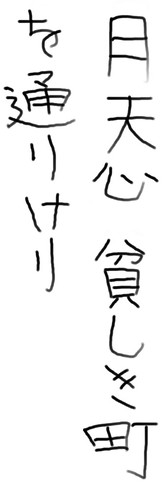Saturday, December 08, 2012
Dconstructing Haiku 3
The haiku poet, Buson is full of tricks. Here is another of his most famous haiku.
月天心 貧しき町 通りけり
Tsuki tennshin, Mazushiki machi, Toorikeri
The Moon mid-sky,
A miserable town,
Passed
I feel sure that wry old Buson is playing with us.
Two things are happening. One is that a big bright moon has passed over a poor town. The other is that Buson has passed through a town of people who were too poor, and I think he hints *too mean*, to let him stay for the night.
The word "mid" in the first phrase, written with the character for "heart" is the centre and key to understanding the poem.
It is pronounced "shin", so is a little too long for the standard Haiku form. By Japanese reckoning, since "n"s are felt to be voiced syllables, "Tsu ki te n shi n" is six syllables as opposed to the standard five.
Similarly, the next phrase "Ma zu shi ki ma chi" meaning (at first glance) "poor town", has only six syllables too, one less than the standard seven, so the "mid"/"heart" character hangs, or vibrates between the two phrases, when with the second hinting at another meaning.
Phonetically it is far to long to fit into the haiku structure, but any Japanese reader will surely feel, consciously or not, the possibility of putting the "heart" character in the second phrase to produce "心貧しい町" (pronounced "kokoro mazushii") meaning "mean-spirited town". I have translated the "poor town" as "miserable town" to hint at the mean-spirited meaning as well.
The moon is very important too. Judging by the high regard and poetic attention placed upon in it the Manyoushuu, the moon is, even more than the sun, the poetic equivalent of the poet's heart. And it is to the moon that the poet, his heart, and the character for heart return.
After looking at the moon, Buson takes us away to the town, to his feeling of rejection, and eventually passing out of it, the poor town, the mean people and the travelling poet's reaction have all "passed". We are left with the image of the full moon which, like the poet's heart, remains as big and round as it ever was.
Buson, who was a fan of Bashou's, uses more devices, such as the double meaning here above, but under my interpretation, the intention is same as a ritual purification at Japanese shrine. Symbolic interpretations are 'swept' away, to return us to a big round, pure mirror: the purity of experience that Nishida refers to as the meeting point between the self and the world.
This blog represents the opinions of the author, Timothy Takemoto, and not the opinions of his employer.

